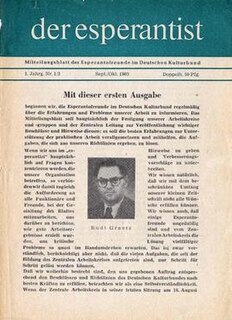
L. L. Zamenhof developed Esperanto in the 1870s and '80s. Unua Libro, the first print discussion of the language, appeared in 1887. The number of Esperanto speakers have increased gradually since then, without much support from governments and international organizations. Its use has, in some instances, been outlawed or otherwise suppressed.
The World Esperanto Youth Organization is an organization dedicated to supporting young Esperanto speakers around the world and promote the use of Esperanto. TEJO was founded in 1938 as the Tutmonda Junular-Organizo and took its current name in 1952. In 1956, TEJO became the youth section of the Universal Esperanto Association (UEA). In 1971, the finances and administration of TEJO were fully integrated into those of UEA.

The Universal Esperanto Association, also known as the World Esperanto Association, is the largest international organization of Esperanto speakers, with 5501 individual members in 121 countries and 9215 through national associations and in official relations with the United Nations. In addition to individual members, 70 national Esperanto organizations are affiliated with UEA. Its current president is the professor Duncan Charters. The magazine Esperanto is the main organ used by UEA to inform its members about everything happening in the Esperanto community.
Norvega Esperantista Ligo was founded in 1911. As the Norwegian arm of the Esperanto movement, its aim is to spread knowledge and use of the international language Esperanto. The league has a modest size of a couple of hundred members, and work done within NEL is mostly voluntary. The youth wing of NEL is Norvega Junularo Esperantista.
The International Union of Catholic Esperantists is an organization of Catholic Esperanto speakers. It was founded in 1910 in Paris and is now headquartered in Rome.
The Canadian Esperanto Association is a registered educational charity whose objective is to advance the education of Esperanto among the Canadian public.

Raymond Schwartz, was a French banker and Esperanto author who wrote many poems and novels in Esperanto, as well as skits which he directed for Parisian Esperanto cabarets.

Detlev Blanke was a German Esperantist. He was an interlinguistics lecturer at the Humboldt University of Berlin. He was one of Germany's most active Esperanto philologists and was from 1991 to 2016 both the chair of the Gesellschaft für Interlinguistik and the editor of its newsletter, Interlinguistische Informationen. He and his wife, Wera Blanke, were especially interested in the evolution of language, particularly in the development of terminology for the constructed language, Esperanto, and questions of sociolinguistics. Blanke made a study of Eugen Wüster's work toward common international terminology and international standardization.
Amerika Esperantisto was a North American Esperanto-language monthly publication founded in January 1907 as Amerika Esperantista Revuo. It was originally published by the American Esperanto Association, a national association formed by Boston Esperantists in March 1905.

Der Esperantist was, from 1965 to 1990, the official newsletter of the East German Esperanto movement.
Rudi Graetz was a German esperantist. He was president of the "Central Workers' Circle of Friends of Esperanto", part of the quasi-governmental Cultural Association in the former German Democratic Republic, and committee member of the Universal Esperanto Association.

Mondpaca Esperantista Movado was an Esperanto association founded in 1953 in St. Pölten, Austria, by Rudolf Burda. Its aim was "utiligi Esperanton serve al paco kaj reciproka kompreno inter la popoloj". Its official magazine was PACO.

The World Esperantist Vegetarian Association is a voluntary association of Esperanto-speaking vegetarians. Founded in 1908, the group's working language is Esperanto, and it is the oldest international organization of vegetarians that is currently active. TEVA published a journal, Vegetarano ("Vegetarian") from 1914 to 1932, revived in 2009 as Esperantista Vegetarano, and has also operated a spirited Internet mailing list through Yahoo! Groups since 2005.

Andreo Cseh was a Hungarian/Dutch Roman Catholic priest and Esperantist known for inventing the Cseh method of Esperanto instruction.
The International League of Christian Esperantists is the association of protestant Esperantists. It was founded in 1911, during the Universal Congress of Esperanto in Antwerp. Its members from very diverse backgrounds, mostly protestant churches. KELI publishes a bimonthly magazine, Dia Regno, which started to appear regularly in 1908, when the German Paul Hübner was sure that five people would subscribe. Now the magazine serves as a tool among members in 48 countries from diverse faiths, Adventists to Quakers, Lutherans, Calvinists, Anglicans, etc., but also people of the Eastern Orthodoxy.

The Esperanto workers movement has the goal of taking practical advantage of the international language Esperanto for advancing the goals of the labour movement, especially the fight against unrestrained capitalism. It is not only a political movement in the strict sense but also a cultural and educational one. Currently the principal Esperanto associations active in the Esperanto workers movement at the global level are the Sennacieca Asocio Tutmonda and the Internacia Komunista Esperantista Kolektivo, and in a wider sense, the Monda Asembleo Socia.

The following outline is provided as an overview of and topical guide to Esperanto:

Anarchism and Esperanto are strongly linked because of their common ideals of social justice and equality. During the early Esperanto movement, anarchists enthusiastically publicized the language, and the two movements have much common history.











